Biol 4106 Exam 3
1/367
There's no tags or description
Looks like no tags are added yet.
Name | Mastery | Learn | Test | Matching | Spaced |
|---|
No study sessions yet.
368 Terms
All tapeworms infecting man belong to the orders: ___ and ____
Cyclophyllidae and Pseudophyllidae
Cestodes lack which three systems?
digestive, respiratory, circulatory
What is the scolex of a cestode?
- anterior end of the tapeworm
- equipped with a holdfast organ, sucker organ, and usually an armed rostellum (there are exceptions)
What are the three kinds of holdfast organs found on scolices?
suckers, hooks, grooves
What are the two kinds of sucker-like organs found on scolices of cestodes?
acetabula or bothria
What is an acetabula?
sucker like organ; circular or oval cup-shaped with muscular wall; usual pattern: 4 equally shaped around the scolex
What is a bothria?
sucker like organ; "slit-like" shallow pits or long grooves; usually 2 in number; lateral or dorsoventral in location on scolex
What is a rostellum?
- protruding dome shaped area on the anterior end of the scolex
- "armed"- hooks are arranged (this is the rule)
- can be unarmed with no hooks (exception)
- presence and absence of rostellum and shape and arrangement of hooks are identification keys for cestodes
If you want to kill a tapeworm, you need to target the ___
neck
What is the significance of the neck on a cestode?
it contains stem cells that give rise to new proglottids (region between scolex and strobila segments)
What is the strobila of a cestode?
long chain of proglottids (segments); each has sets of reproductive organs of both sexes
What is strobilization?
- the growth of strobila from the anterior end as new proglottids are added
- proglottids closest to the scolex are the most immature
- as move further to posterior end, sexual maturity occurs putting "oldest and most mature" proglottids at posterior end of strobila
What is a gravid proglottid?
proglottids in the strobila that are filled with eggs (located at the posterior end of the strobila)
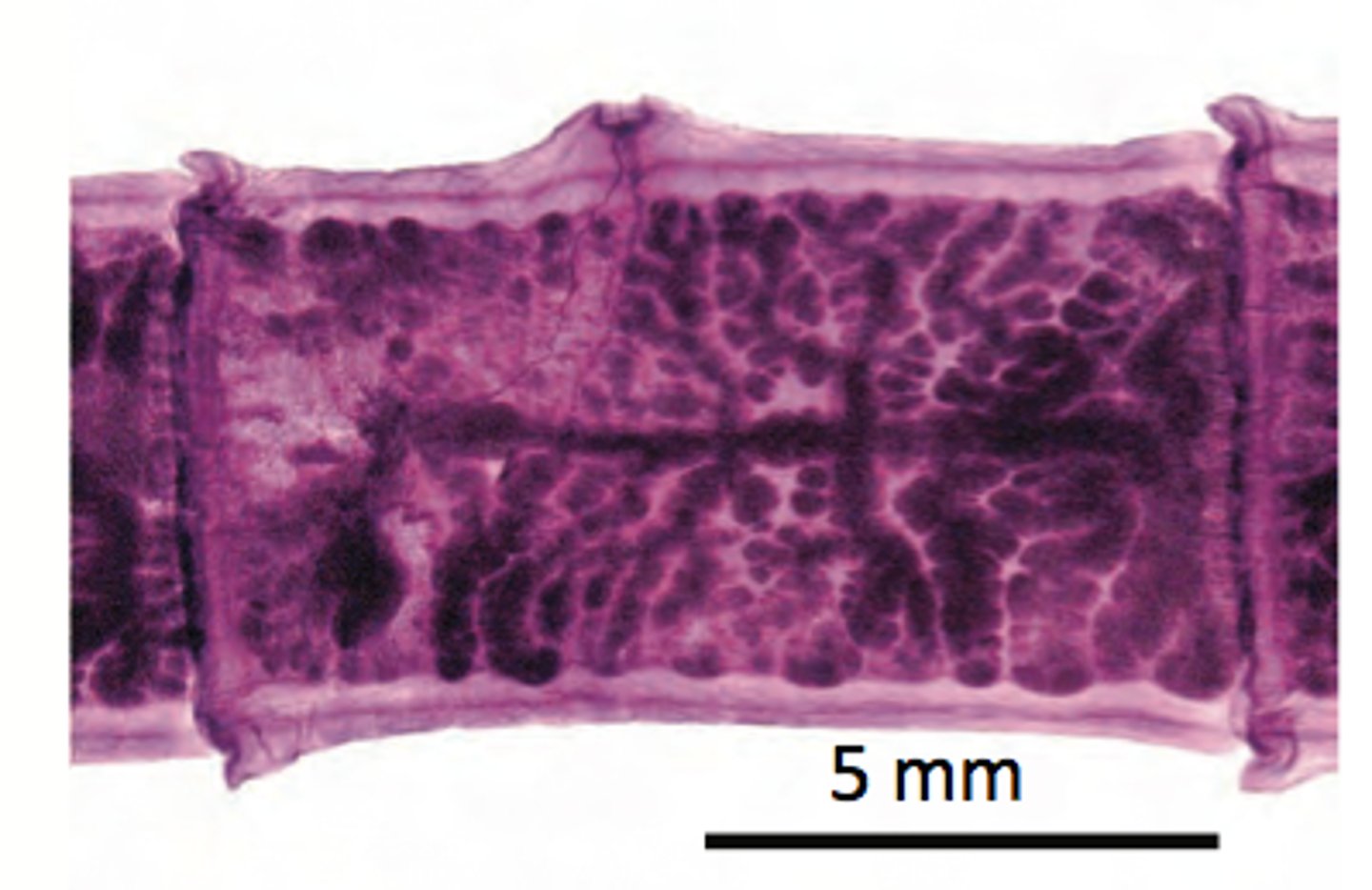
What are the three ways that proglottids can be shed?
1. intact gravid proglottid detaches and is shed intact in the feces (Taenia, Dipylidium spp)
2. proglottid disintegrates as shed and eggs go out with feces (Hymenolepsis, Echinococcus spp)
3. eggs shed from attached proglottid through uterine pore and senile (empty) proglottids detach in a short chain which is shed in feces (Diphyllobothrium spp)
What is a senile proglottid?
- an empty, formerly gravid proglottid that has shed all the eggs in the uterus and is no longer producing any eggs
- seen in Diphyllobothrium spp
What are the three functions of the tegument of a cestode?
absorption, excretion of wastes, osmoregulation
How does a tegument of a cestode accomplish absorption?
- all nutrients are absorbed through the tegument
- there is no GI tract in cestodes
- covered in microvilli called "microtriches" even on the suckers to increase absorptive area of the tegument
What are the two layers of muscle tissue on a proglottid of a cestode?
longitudinal layer and transverse layer, which enables each segment to move independently
Describe the nervous system of cestodes
- well developed
- has tactoreceptive and chemoreceptive sensors
Cestodes are (monoecious/ diecious)
monoecious, hermaphroditic
How are cestodes monoecious?
- hermaphroditic with 1 or 2 complete sets of male and female reproductive organs per proglottid
- fertilization occurs when reproductive systems mature as proglottids move toward posterior part of the strobila
- sperm transferred between mature proglottids that lie next to each other in intestine of definitive host (self-fertilization is exception, not the rule)
What are the two kinds of cestode eggs?
Dipylidium type and Taenia type
What is the general morphology of Dipylidium type cestode eggs?
thin shelled, operculated in Diphyllobothrium latum and in egg packets for Dipylidium caninum
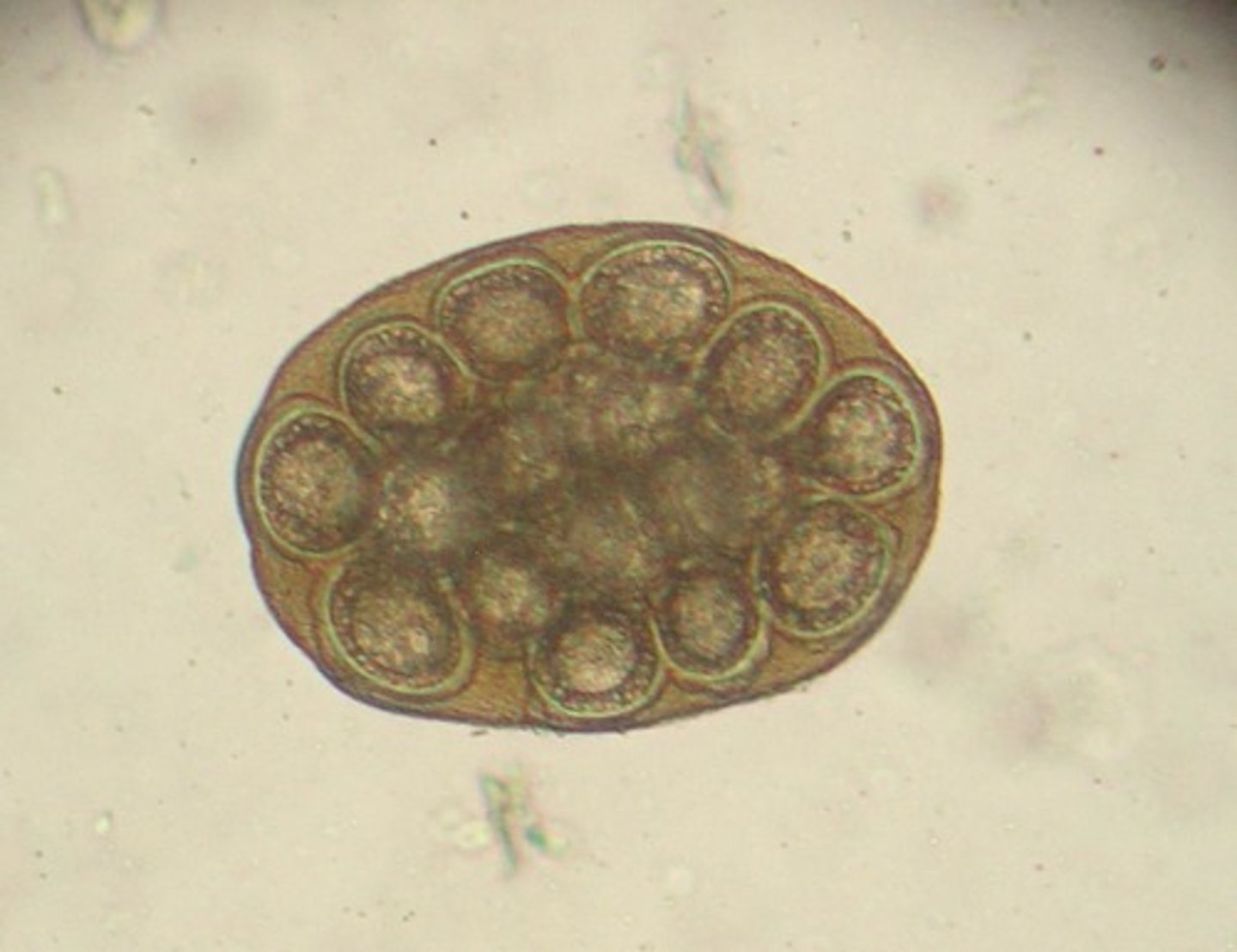
Which genera of cestodes have Dipylidium type eggs?
Diphyllobothrium spp, Dipylidium caninum, Hymenolepsis spp
What is the general morphology of Taenia type eggs?
thick striated shell, hexacanth embryo within
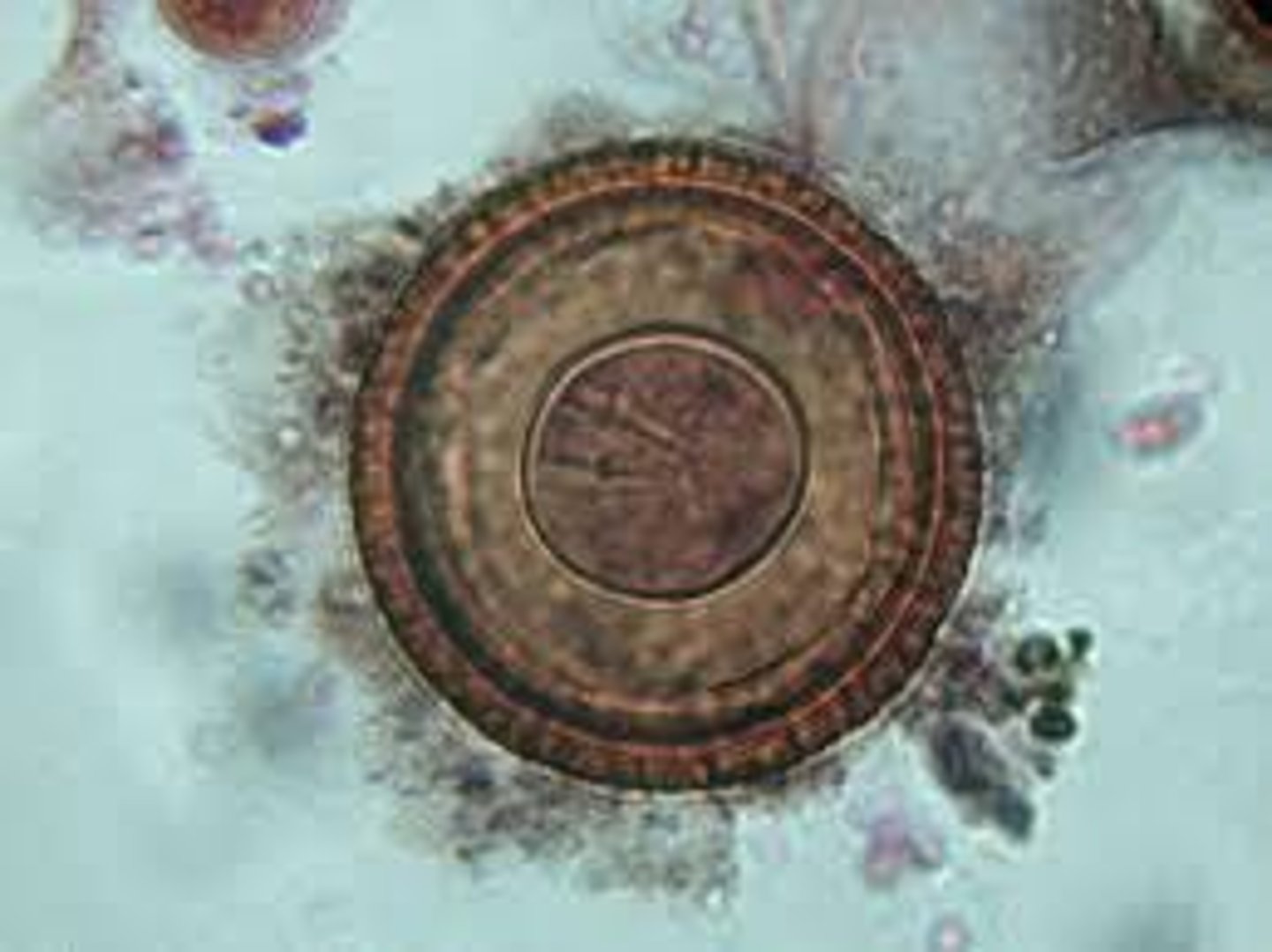
Which genera of cestodes have Taenia type eggs?
Taenia spp, Echinococcus spp
What is an onchosphere?
the hexacanth larva in an egg
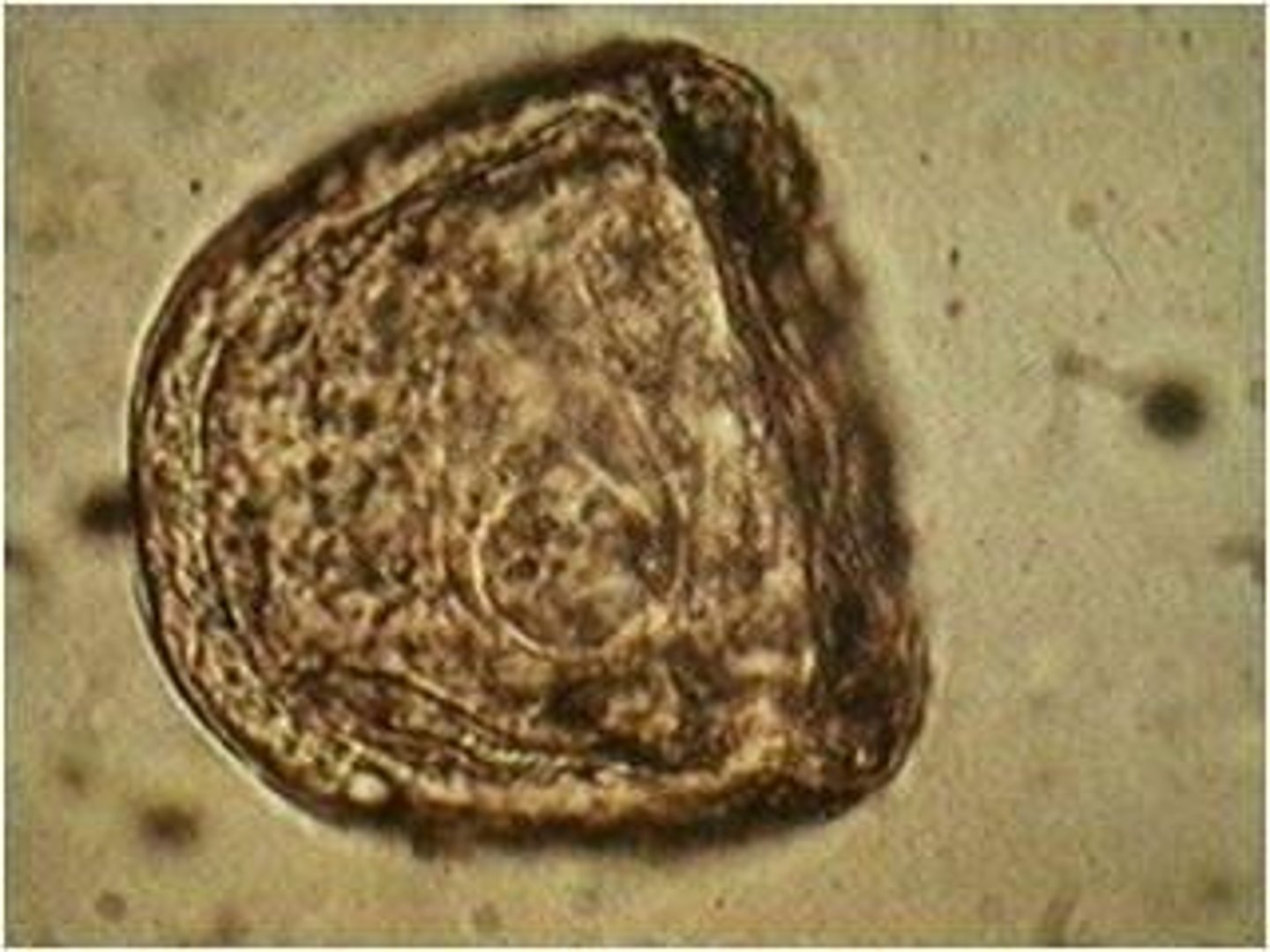
What is a metacestode?
juvenile (larval) form of tapeworm found in intermediate host
What is the general life cycle of cestodes?
egg -> onchosphere (in egg) -> metacestode(s) (in intermediate host) -> adult worm (in definitive host)
How many metacestode stages does the Pseudophyllidean life cycle have?
two
What is the onchosphere of a Pseudophyllidean called?
coracidium
What is the general life cycle of Pseudophyllideans?
egg -> onchosphere = coracidium -> procercoid -> plerocercoid -> adult
What is a coracidium?
- onchosphere inside Pseudophyllidean egg
- egg must get in water to hatch
- ciliated free-swimming onchosphere hatches out
- can survive on its own for only a short time (must be eaten by intermediate host)
- has hooks that help penetrate through copepod gut
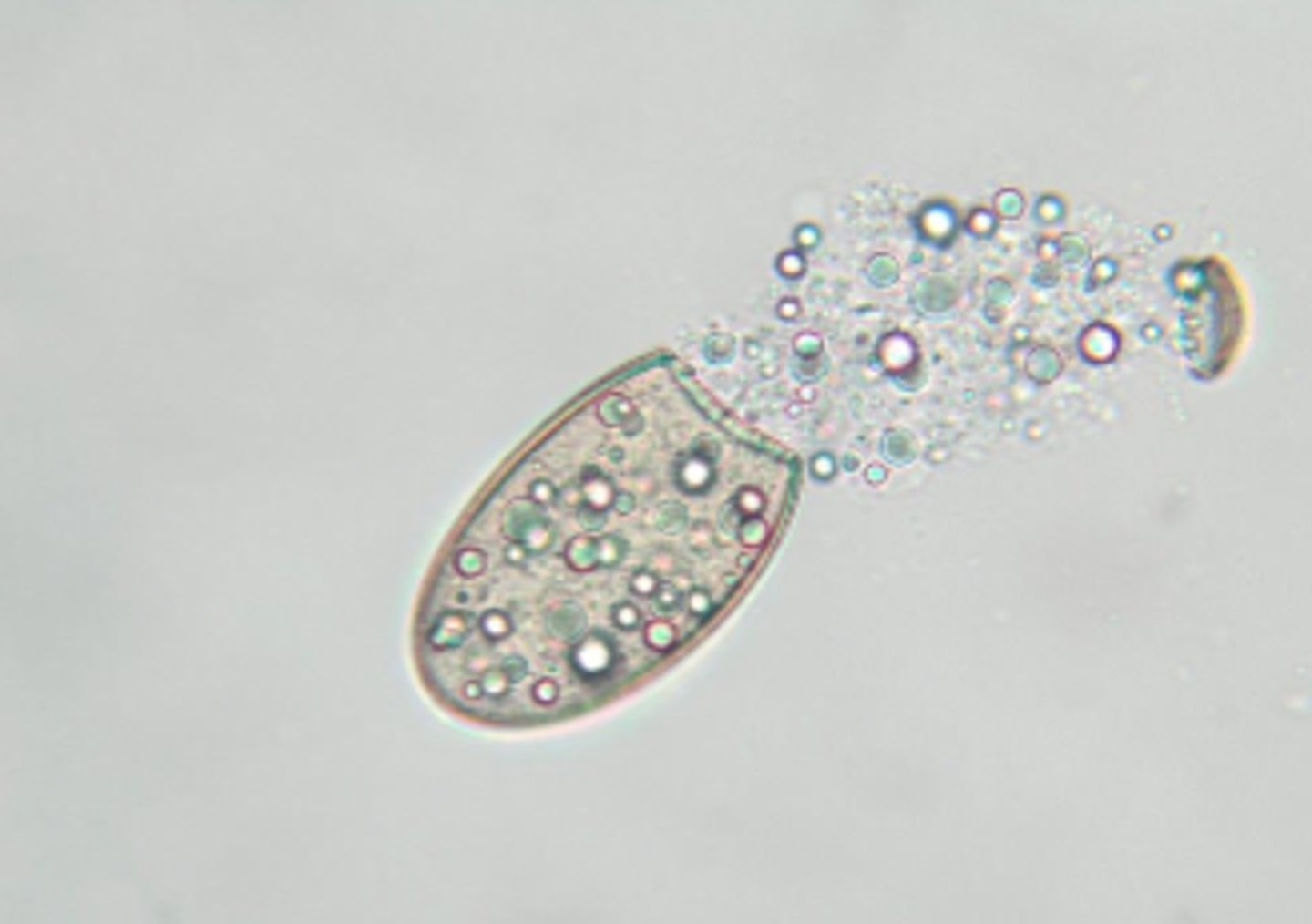
What is a procercoid?
- metacestode stage found in the 1st intermediate host (copepod) of Pseudophyllideans
- loses cilia and penetrates through gut into coelom and into tissue
- still has onchosphere hooks seen in the coracidium (used to help attach and penetrate through 1st host tissues)
- now in structure called cercomer
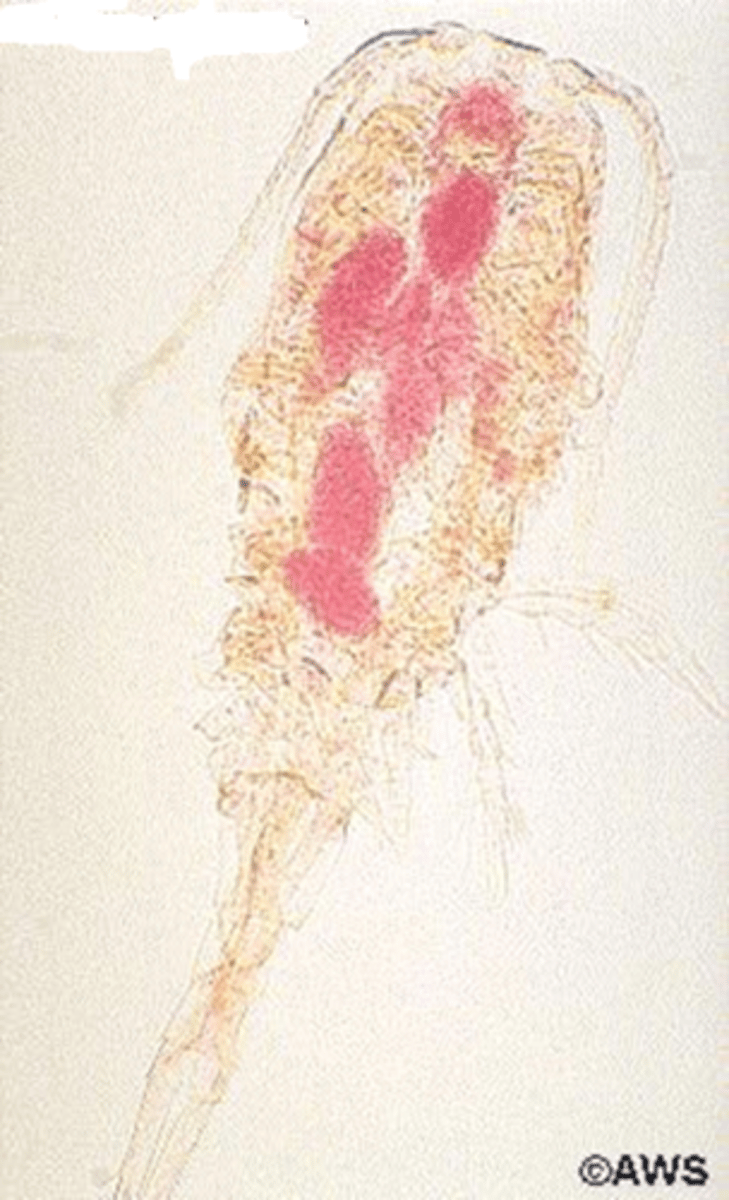
What is a plerocercoid?
- metacestode stage of Pseudophyllideans found in 2nd intermediate host
- procercoid penetrates through gut wall, migrates to muscle and becomes plerocercoid
- this is the infective stage for the definitive host
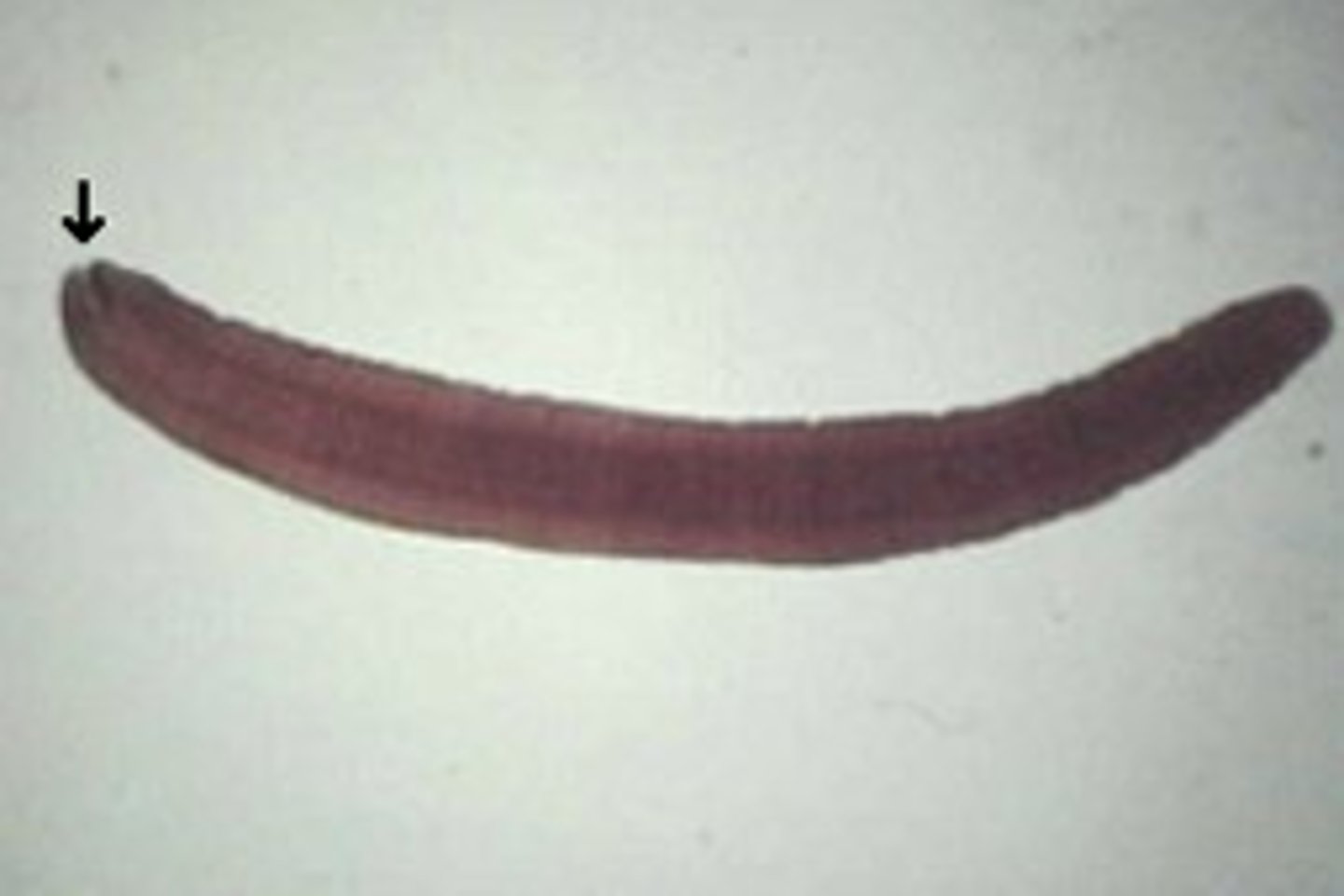
What is a sparaganum?
term for plerocercoid of Diphyllobothrium (Spirometra) mansonoides
What is the difference between procercoid and plerocercoids?
plerocercoid develops a scolex and has some strobila formation (true juvenile cestode)
What happens if a large 2nd intermediate host for a cestode eats a smaller, plerocercoid- infected 2nd intermediate host (big fish eats infected small fish)?
plerocercoid invades new 2nd intermediate host muscle tissue and remains as a plerocercoid; cannot develop to adult until in the definitive host
How many metacestode stages are in the Cyclophyllidean life cycle?
1
What is the general life cycle of Cyclophyllidean cestodes ?
egg -> onchosphere -> metacestode -> adult
Where do eggs of Cyclophyllidean cestodes embryonate?
in the feces of the definitive host and can remain viable in soil for weeks to months
What must occur for hatching of a Cyclophyllidean egg?
- egg must be eaten by intermediate host for hatching to occur
- onchosphere uses hooks to penetrate through gut wall and into tissues to transform to metacestode form
What are the four metacestode forms of Cyclophyllideans?
1. Cysticercoids
2. Cysticercus (plural Cysticerci)
3. Coenurus
4. Hyatid Cyst
What is a cysticercoid?
- metacestode of Cyclophyllideans
- solid cyst with single, inverted scolex
- intermediate host is invertebrate
- found in Dipylidium and Hymenolepsis species
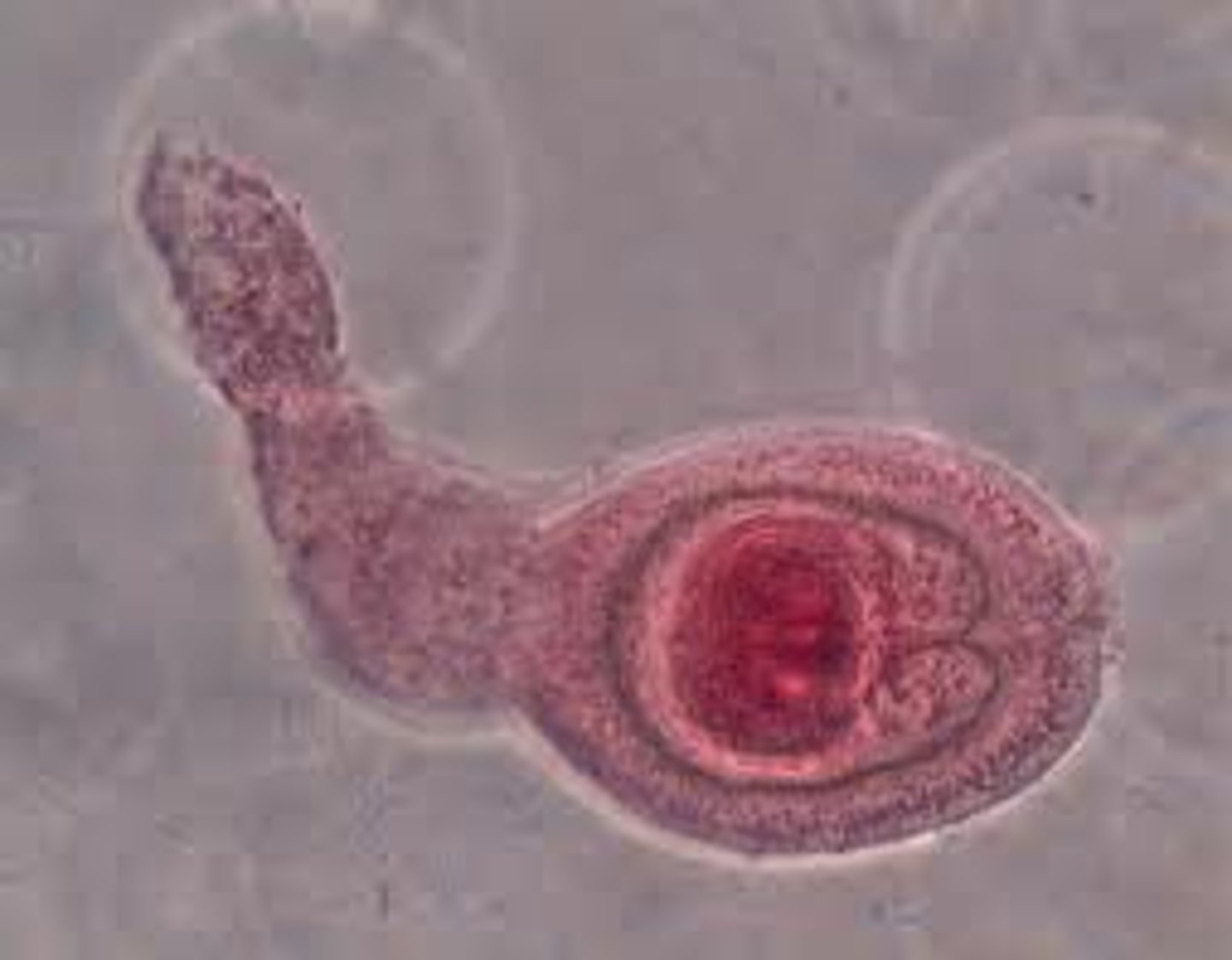
What genera have cysticercoids as their metacestode stage?
Dipylidium and Hymenolepsis
What is a cysticercus?
- metacestode form of Cyclophyllideans
- fluid filled cyst with scolex inverted and invaginated
- intermediate host is a vertebrate
- found in Taenia species
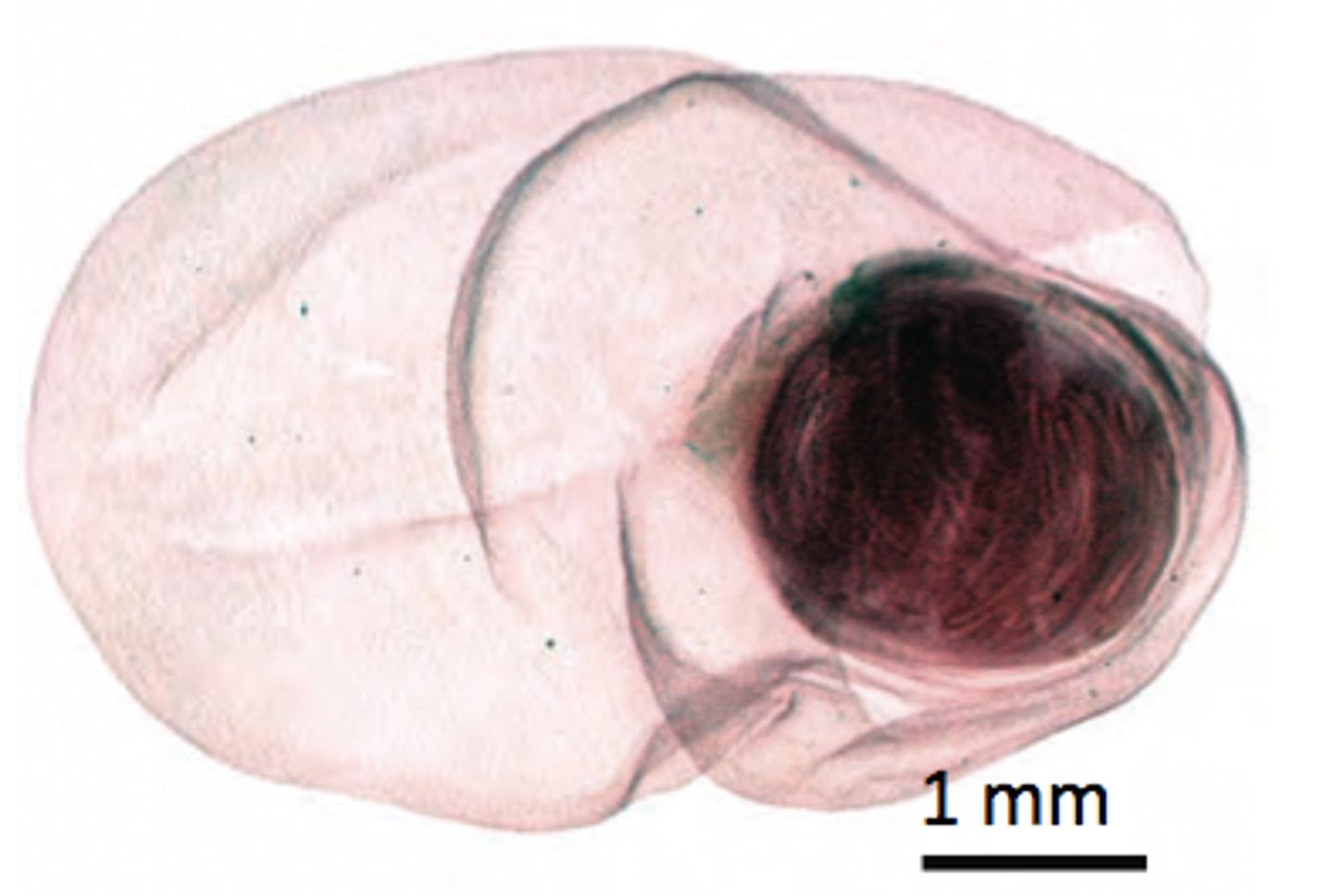
Which genera have cysticerci as their metacestode stage?
Taenia species
What is a coenurus?
-metacestode form of Cyclophyllideans
- fluid filled cyst with several inverted scolices, each on a stalk
- intermediate host is a vertebrate (usually)
- found in Multiceps species- Taenia serialis and Taenia multiceps

Which genera have coenuri as their metacestode stage?
Multiceps - Taenia multiceps and Taenia serialis
What is a hyatid cyst?
- metacestode form of Cyclophyllideans
- intermediate host is a vertebrate
- grow slowly but can be large containing quarts of fluid
- most complex of larval forms
- cyst lined with germinal epithelium that give rise to individual protoscolices and daughter capsules
- can be unilocular or multilocular
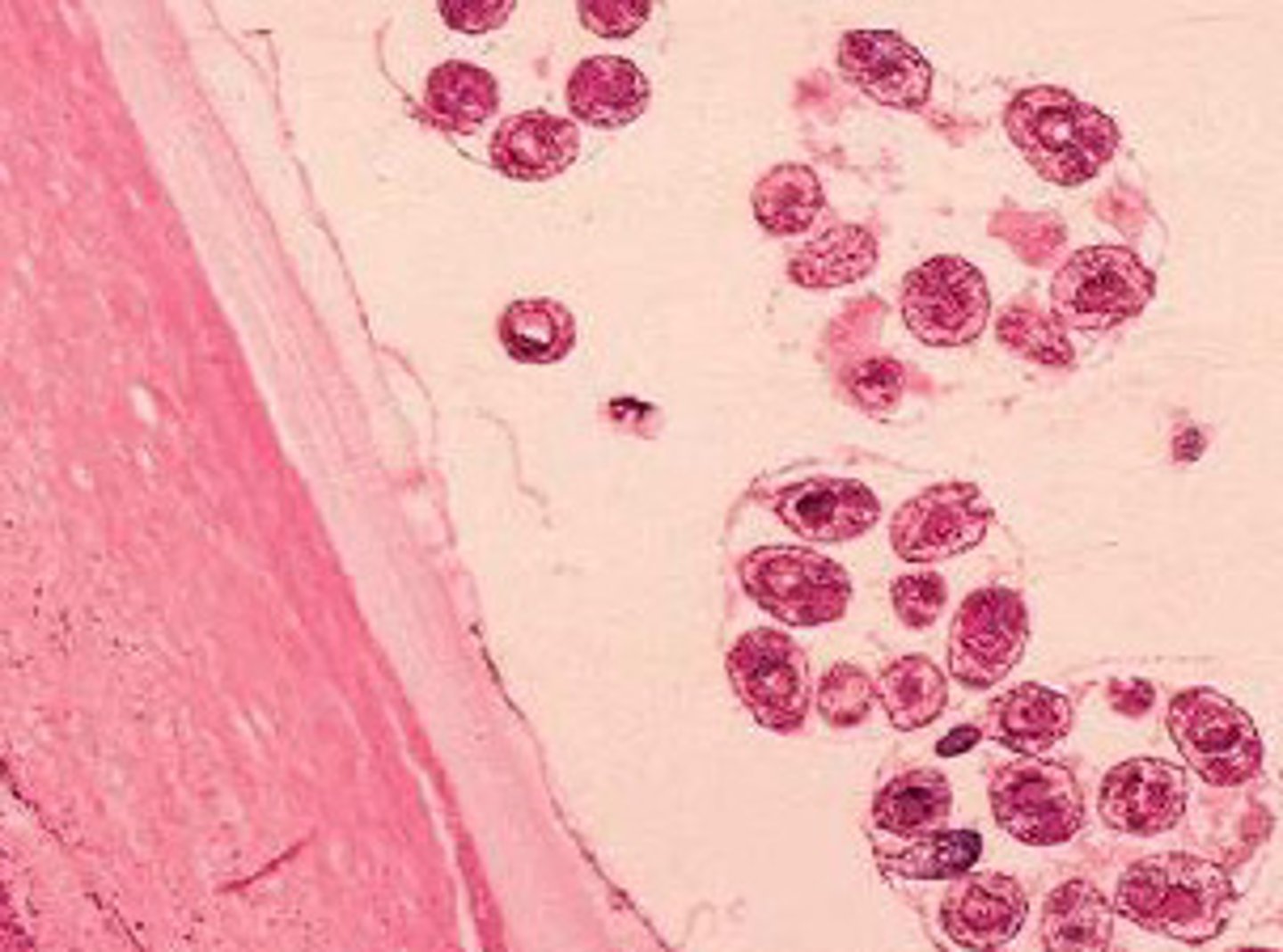
What is hyatid sand?
a granular deposit in hyatid cysts consisting of liberated daughter capsules and free protoscolices
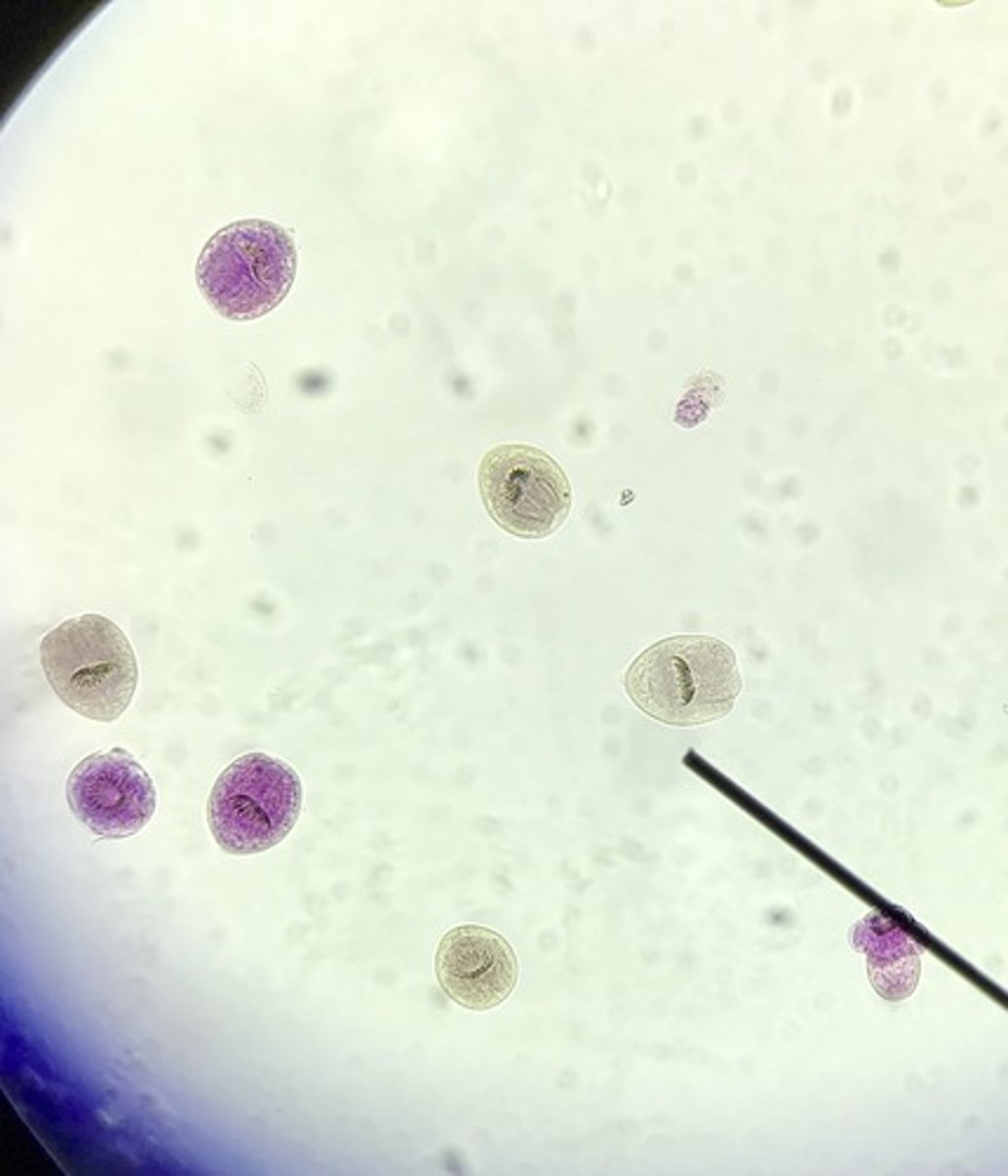
What are the two types of hyatid cysts?
unilocular and multilocular
Which species of Echinococcus has unilocular hyatid cysts?
Echinococcus granulosus
What is a multilocular hyatid cyst?
- hyatid cyst where daughter capsules bud externally
- as daughter cysts bud outward, multilocular cyst invades tissues of infected organs
- makes form highly invasive like aggressive metastatic tumor as parasite tissue replaces host organ tissue
- seen in E. multilocularis infection
Which species of Echinococcus has multilocular hyatid cysts?
Echinococcus multilocularis
What are the general characteristics of Pseudophyllideans?
- scolex with bothria
- proglottids remain attached and shed eggs through pore
- shed chain of senile proglottids
- genital pores are central
- eggs are operculated (like trematodes)
- 1st intermediate host is a crustacean (copepod)
- 2nd intermediate host is a fish
- definitive host can be human
What kind of sucker is found on the scolex of Pseudophyllideans?
bothria
Where are the genital pores of Pseudophyllideans located?
genital pores are central
How are proglottids shed in Pseudophyllideans?
- proglottids remain attached and shed eggs through pore
- shed chain of senile proglottids
What is the 1st intermediate host of Pseudophyllideans?
crustacean- usually a copepod
What is the 2nd intermediate host of Pseudophyllideans?
fish
Which two species of cestodes are Pseudophyllideans?
Diphyllobothrium latum; Diphyllobothrium mansonoides (Spirometra mansonoides)
What is the distribution of Diphyllobothrium latum?
worldwide- Scandanavia, Japan, Russia, China, South America, West Coast, and Great Lakes region of North America
What is the 1st intermediate host of Diphyllobothrium latum?
- copepod (procercoid stage)
- eggs deposited in freshwater for cycle to continue
- coracidium hatch and eaten by copepod for cycle to continue
What steps occur in the first intermediate host (copepod) in the life cycle of Diphyllobothrium latum?
- eggs deposited in freshwater
- coracidium hatch and are eaten by copepod
What is the 2nd intermediate host of Diphyllobothrium latum?
- freshwater fish (plerocercoid stage)
- usually a minnow that eats the copepod
- can be repeated many times until fish large enough to be eaten by definitive host
What are the steps in the 2nd intermediate host (freshwater fish) in the life cycle of Diphyllobothrium latum?
a fish eats the copepod and this repeats until eaten by a fish large enough to be eaten by a human or other definitive host; forms plerocercoid stage
What is the definitive host of Diphyllobothrium latum?
fish eating carnivores
How is Diphyllobothrium latum transmitted to the definitive host?
by eating raw or undercooked fish containing Diphyllobothrium latum plerocercoids; they are carried to the small intestine and attach to the wall of the gut by bothria
Diphyllobothrium latum causes little to no pathology unless:
- affinity for vitamin B12 causes specific anemia in genetically susceptible individuals
- adult parasite requires high amount of B12
- 2% of infected human population can develop megaloblastic anemia from worm exhausting supply of B12
- individuals have genetic defect where they cannot produce enough intrinsic factor needed for B12 absorption in diet
Diphyllobothrium latum has an affinity for which vitamin?
b12
What genetic defect causes pathology from Diphyllobothrium latum infection?
people who cannot produce enough intrinsic factor, which they need to absorb B12 in the diet
What is the morphology of Diphyllobothrium latum adults?
- large worm up to 10-15 m
- usually one worm per host
- proglottids wider than long
- centrally located genital pore through which eggs pass
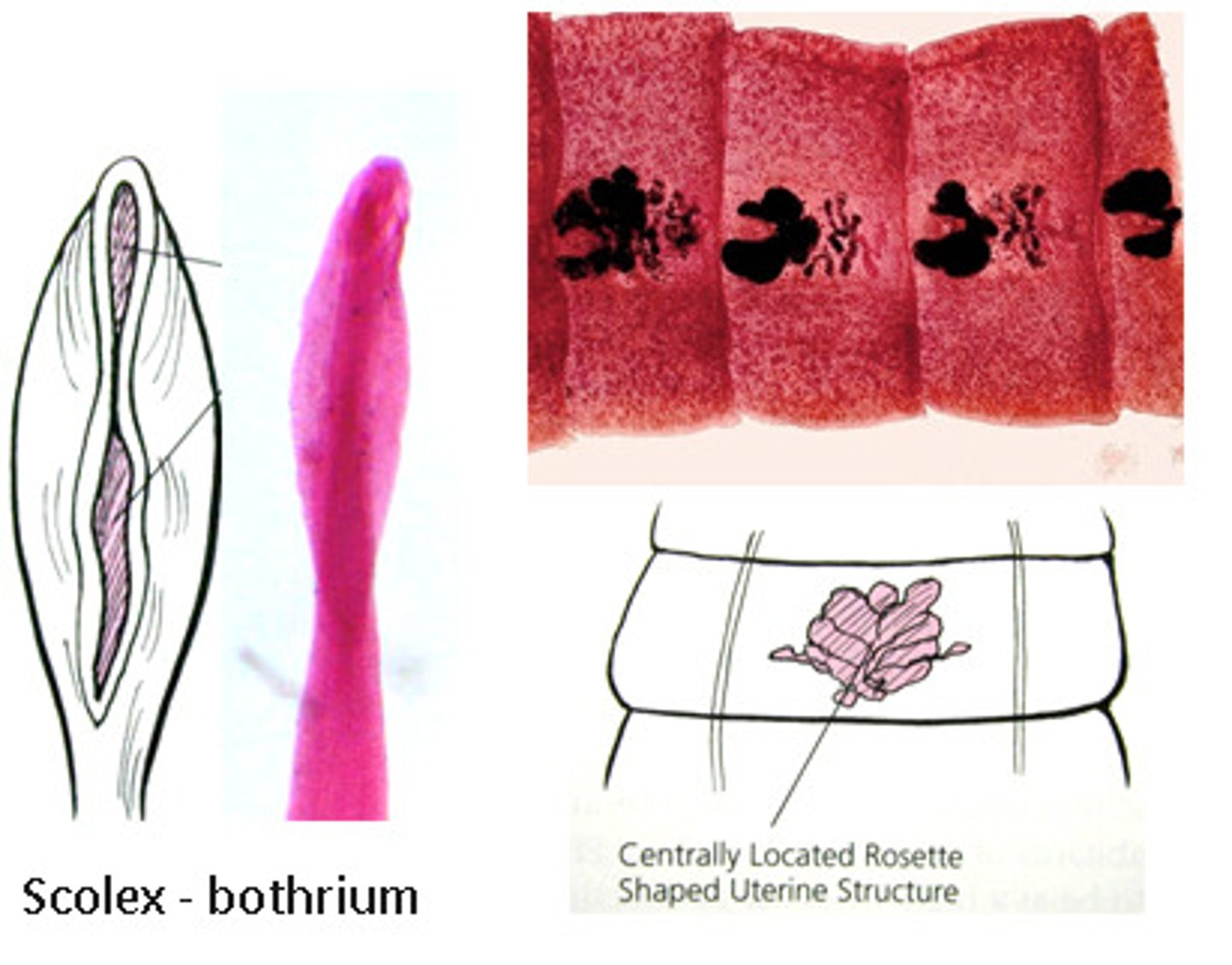
What is the morphology of Diphyllobothrium latum eggs?
- eggs passed are fertilized, unembryonated and operculated with thin shell (look like trematode egg)
- prolific reproducer: females produce million eggs per day
- proglottids shed only when no longer producing eggs

How is Diphyllobothrium latum infection diagnosed?
finding long string of exhausted (senile) proglottids in feces
How is Diphyllobothrium latum infection prevented?
do not eat raw freshwater fish or raw salmon
What is the life cycle of Diphyllobothrium latum?
-eggs in freshwater hatch into free swimming coracidium
-copepod eats coracidium and becomes procercoid
-minnow eats infected copepod containing procercoid
- plerocercoids form in muscle
-fish eats infected minnow
-plerocercoid ingested with raw or undercooked fish
-adults live in the small intestine -scolex with bothria
- adults can grow 10-15 m in length
- eggs passed through genital pore and then senile proglottids shed
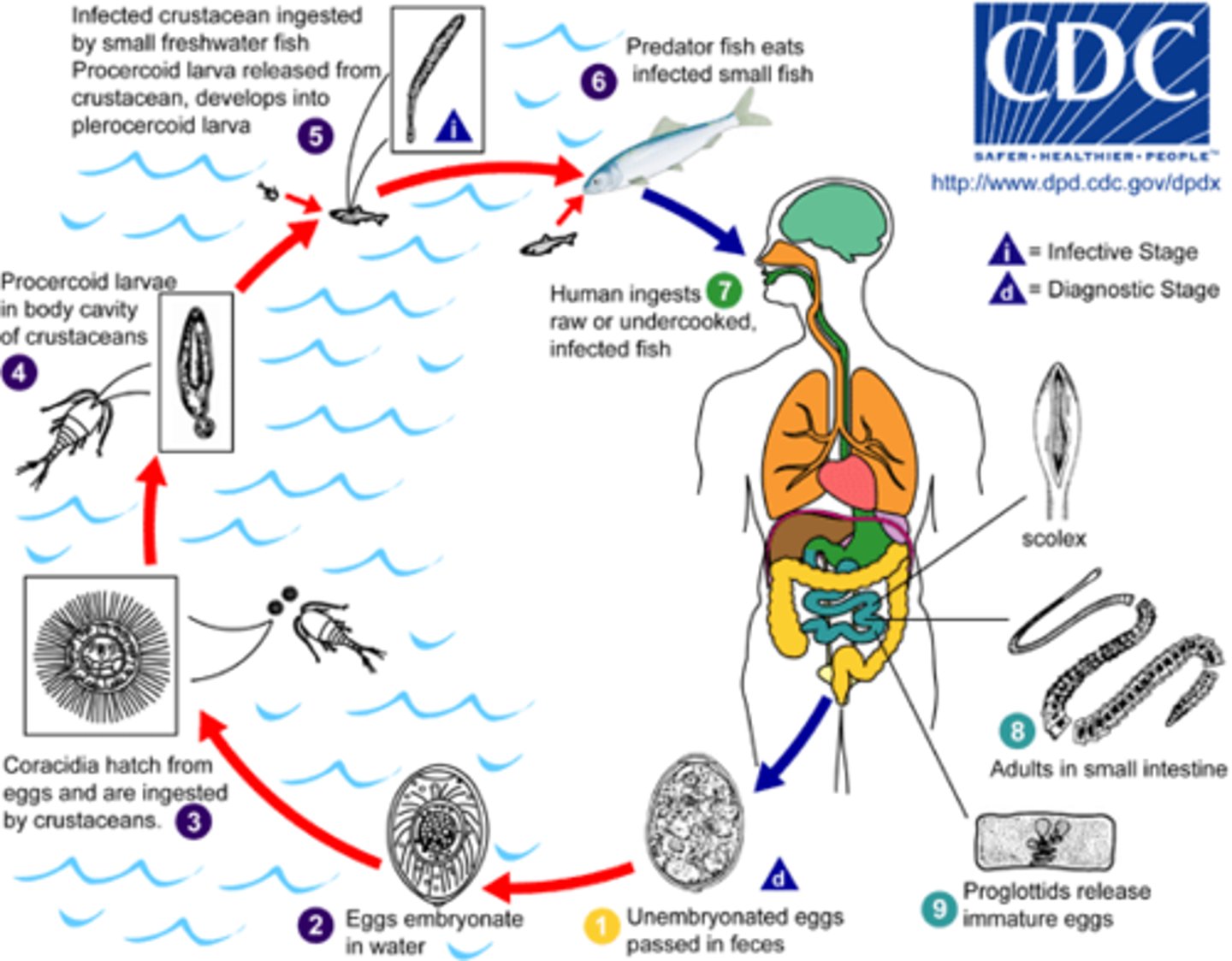
Diphyllobothrium mansonoides causes infection commonly called ___
sparganosis (note: plerocercoid is called a "sparganum")
What is the definitive host of Diphyllobothrium mansonoides?
felines and canines (not humans)
What is the first intermediate host of Diphyllobothrium mansonoides?
copepod or other small crustacean
What is the second intermediate host of Diphyllobothrium mansonoides?
- can be a wide range of vertebrates
- plerocercoids have capacity to develop in almost any animal and almost indefinite plerocercoid transmission can occur before being ingested by definitive host
Humans can be infected with ___ or ___ stages of Diphyllobothrium mansonoides
procercoid or plerocercoid because humans are 2nd intermediate host
What are the three ways that Diphyllobothrium mansonoides can infect humans?
1. by eating raw or undercooked 2nd intermediate host flesh
2. infected by drinking unfiltered or unboiled water with infected copepods in it
3. by following Eastern Asian practice of using frog or snake skin poultices on wounds
Why do people put frog or snake poultices on a wound? (What's the tradition)
- certain secretions from frog skins contain peptides that have bactericidal activity
- problem arises if frog ate intermediate host and has plerocercoids because parasites, may migrate out of skin and enter the wound
- painful nodules form around each plerocercoid
What is the treatment for Diphyllobothrium mansonoides?
none; surgery if the parasite is in an accessible location (plerocercoids can survive for years)
How is Diphyllobothrium mansonoides infection prevented?
don't eat raw or undercooked meat, especially not raw snake and don't wear frog skins
How can Diphyllobothrium latum be identified on a slide?
- scolex and mature proglottids
- uterus darkly staining and rosette shaped in middle of proglottid
- ova resemble trematode eggs
What are the general characteristics of Cyclophyllidean cestodes?
-scolex with 4 acetabula
- generally have rostellum with hooks (armed rostellum) - exception to this is Taenia saginata
-genital pores are lateral
- eggs with thick, striated shells and containing hexacanth embryo
Which cestodes are considered Cyclophyllideans?
Taenia spp, Dipylidium sp, Hymenolepsis spp, Echinococcus spp
What is the common name of Taenia saginata?
beef tapeworm
What is the distribution of Taenia saginata?
anywhere beef is consumed in the diet and there is a lack of sanitation
What is the general morphology of Taenia saginata adults?
- no rostellum
- scolex with 4 acetabula
- immature and mature proglottids are slightly wider than long
- gravid proglottids are longer than wide
- gravid proglottids are shed intact and are motil
-shed proglottids dry out, rupture, and release eggs
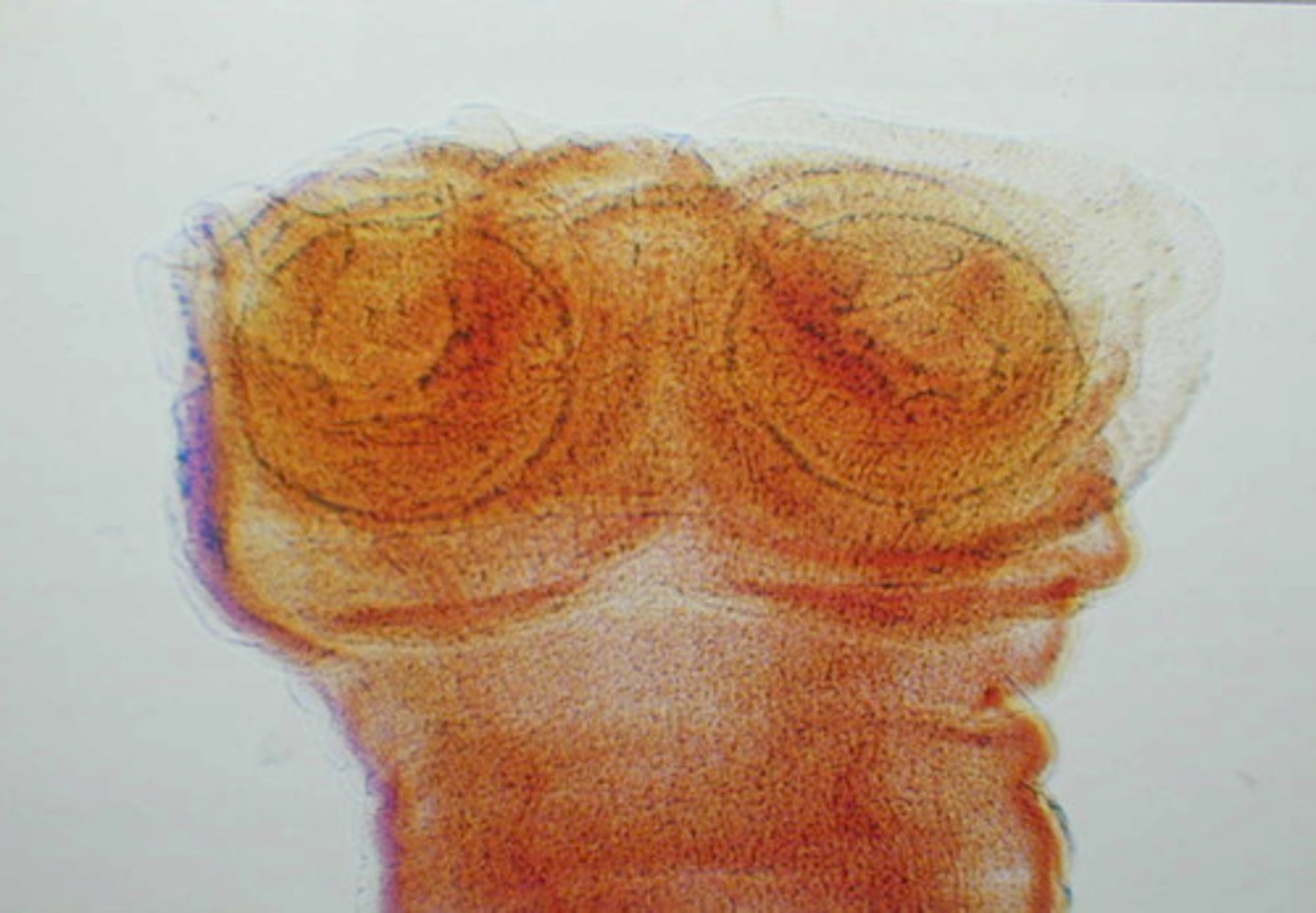
What is the morphology of Taenia saginata eggs?
characteristic thick, striated shell with hexacanth onchosphere within (onchosphere has 3 pairs of hooks = six hooks)
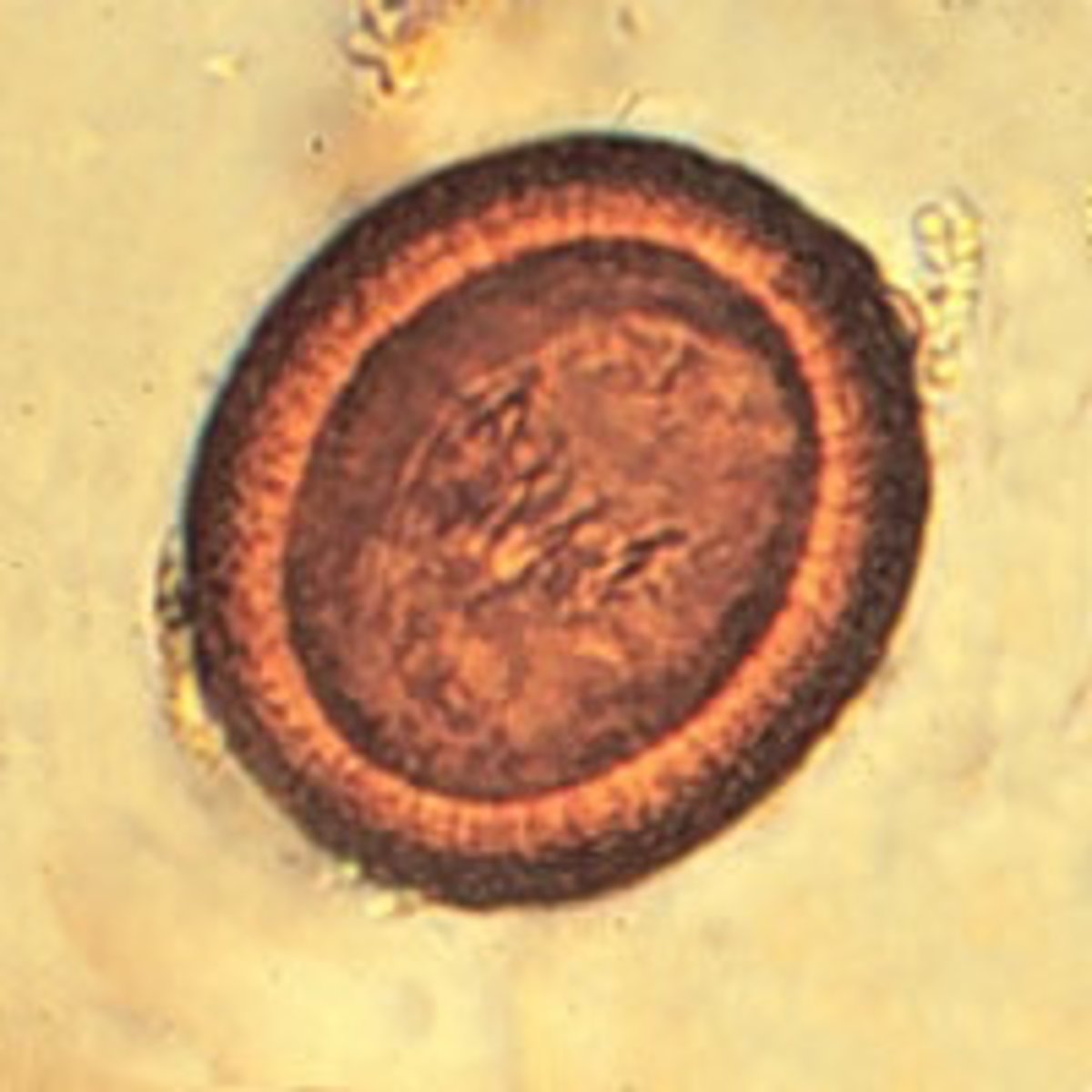
What is the intermediate host of Taenia saginata?
cattle (herbivores) ; eggs will hatch only in digestive system of the herbivore
What is the definitive host of Taenia saginata?
man
What is the life cycle in Taenia saginata?
- eggs with hexacanth are eaten by cattle
- hatch in the small intestine
-hexacanth uses hooks and penetrates gut wall
-enters bloodstream
-leaves capillary into striated skeletal muscle tissue
-develops into cysticercus
-man eats undercooked beef
-scolex everts from cysticercus and attaches to small intestine wall
- rest of cysticercus digested away
-2-12 weeks later gravid proglottids are being shed in feces
-gravid proglottids may actively migrate out anus at night
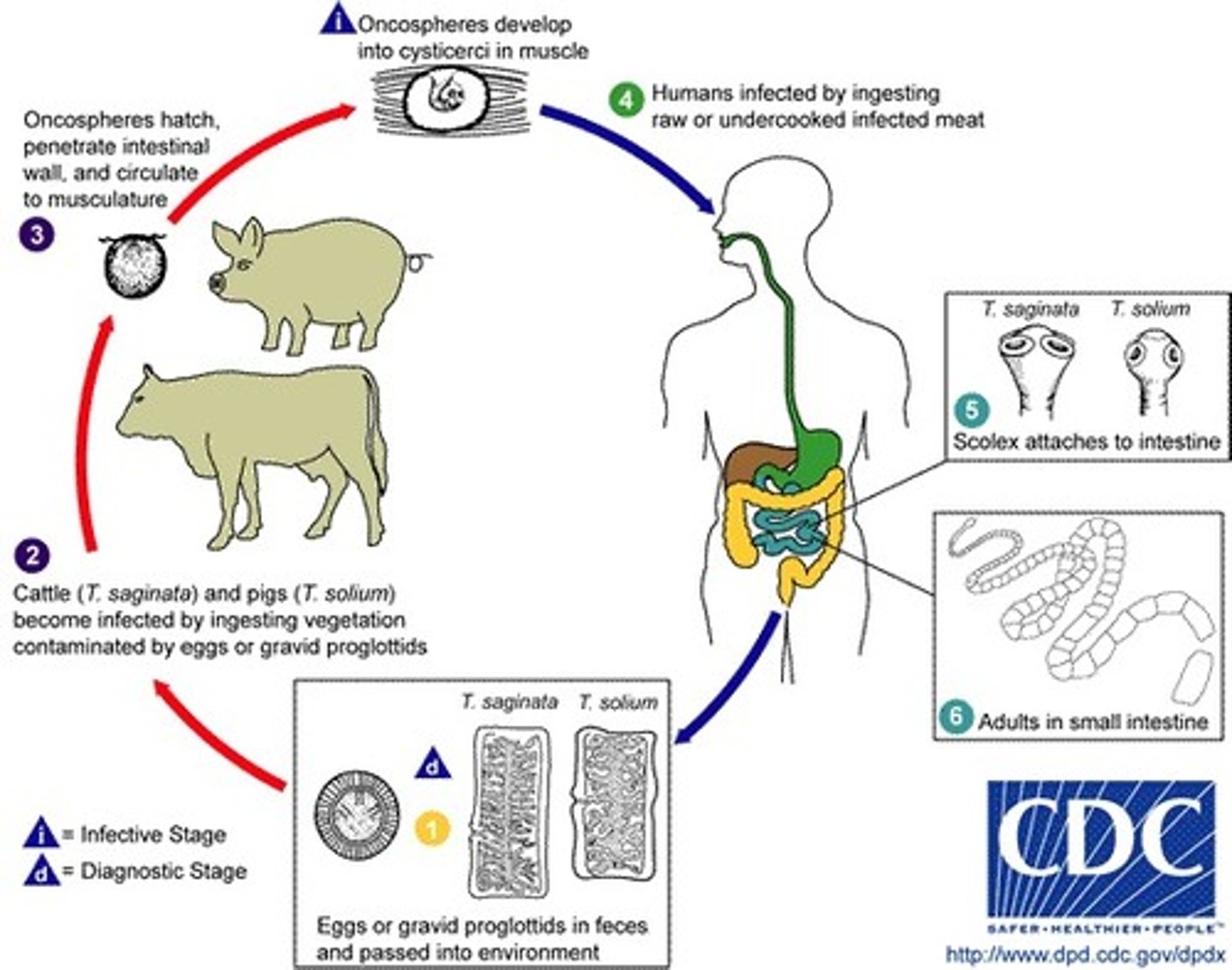
What is the metacestode stage of Taenia saginata?
cysticercus
How can Taenia saginata infection be prevented?
cooking will prevent disease
freezing at -5ºC for at least 1 week
What is the common name of Taenia solium?
pork tapeworm
What is the distribution of Taenia solium?
SE Asia, Mexico, South and Central America, Eastern Europe, Micronesia, Philippines